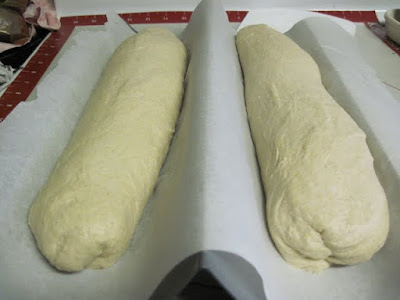I decided to do a step by step of my first Hamelman's recipe, from "Bread". I thought I would share previous loaves of Sourdough bread that I have made in the past month or so. These first two pictures are of the breads I finished baking today from "Bread". The step by step directions are below the comparison shots.
 |
| From HamelmansWWLevain |
Here's the crumb shot from one of the two loaves. I made them with Fresh Ground Winter White Wheat, and it is a 50% WW and 50% bread flour sourdough (levain) bread. My starter "Arnold" has been alive since Thanksgiving, and normally has a really nice sour twang to it. I have made sourdough breads for quite a long time, but for some reason I simply stopped baking breads for quite a few years.
The next picture is of a 100% WW sourdough bread. I made it with fresh ground Winter Red Wheat, and did not add any bread flour to it. Ingredients were WW, water, salt, and starter.
The next two pictures are of a loaf made with 100% Winter White Wheat, fresh ground. It's ingredients were also simply WW, water, salt, starter.
I sliced this one in half lengthwise, because I made sandwiches out of it.
I miss the open crumb I find in my regular unbleached ap or bread flour sourdough loaves. Guess I am a little bit spoiled by that, and I could actually eat only sourdough white bread and be totally happy. The flavor of the wheat is nice, but I really enjoy the sour taste from a loaf of white flour sourdough. Trouble is that it is probably really not that good for me! Fresh ground whole wheat is a much better choice, and has a wonderful flavor of it's own. I am hoping to get better at producing the open crumb with a whole wheat bread. Practice practice practice....
Here is a little bit of Arnold about to be mixed into the water. He is a 100% Whole Wheat sourdough starter.
Whole Wheat added to the levain (starter).
Here is the poolish/levain/starter ready to sit out overnight. It was nice and moist, but thick like a poolish/sponge should be. Arnold had a nice smell to him before adding him to the mix.
Here's a picture of the dough which I kneaded for about 4 minutes, on speed setting #2. My kitchenaid says that I should only use the #2 setting when making breads. The dough nicely toes out at the bottom, and cleans the side of the bowl. I thought it might be a little bit dry, and I think next time I will follow my instincts and put a little bit more water in.
I pulled it out and put it into a greased bowl. It felt a little underdeveloped from what I normally do, but I knew that it called to be folded a couple times which would make it stronger.
Nice looking dough after the initial fermentation, still on the dry side for wanting an open crumb.
Split ready for weighing and shaping.
Rough shaping almost finished, allowed to rest ten minutes, and then made them longer into a baguette shape. I like baguettes for sourdough and french breads.
Ready for an overnight rest in the fridge. I will pull them out in the morning and let them warm up and rise before baking.
Ready to cool off. Second picture of loaves just pulled from the oven. Need more practice with my razor blade, although it's possible I simply can't get enough steam in my oven to allow the bread to open up like it should. I am also used to baking my breads at 500* for 5 minutes and then turning the temp down to 450* so when I put these in and didn't think about it and simply did it that way. We live at 3821 feet above sea level, so I don't believe the temp difference was that great.


.JPG)
.JPG)










Nice looking breads! Its interesting to see all those breads together and notice the difference in color and the crumb structure between them. Now if we could only sample taste them too, we could compare flavor as well:)
ReplyDeleteHi Joanne, what an interesting post! I've never seen side by side shots of different varieties of American wheat before, and they are quite different aren't they? Which is your personal favourite so far? They all look very desirable to me and I am not a big fan of wholewheat breads normally but that might be our coarse wholemeal flour...
ReplyDeleteLol, Melanie, I agree the true test of bread is taste!
ReplyDeleteI grind my own wheat using a Nutrimill set to the fine setting. It really does come out fine, not like a hand mill which produces coarser grain. I am not a fan of the coarser flours either, just seem to make bricks with it!
My preference is for the Winter White Wheat, it has a milder flavor and doesn't overwhelm the flavor of pizza or cinnamon buns, even when I use 100% fresh ground flour in them. I love lean white breads. When using regular yeast this flour actually makes very nice loaves of bread, even at 100% Whole wheat.
The only time I prefer the Hard Red Wheat is when I am making a soaker bread. I like to add about 5% cereal grains, plus raisins and cardamon to it, and the extra flavor really compliments the bread. I usually use that as a toasting bread for breakfast, and it is always 100% Hard Red Wheat flour.